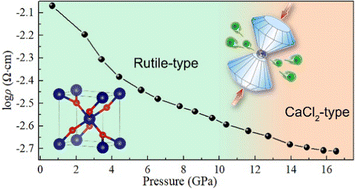High-pressure magnetic properties and electrical transport behaviors of half-metallic ferromagnet CrO2†
Abstract
The magnetic properties and electrical transport behaviors of half-metallic ferromagnet chromium dioxide (CrO2) powders under high pressure have been investigated by in situ electrical resistivity, magneto-resistivity, and Hall-effect measurements. Our results reveal that the Hall coefficient, carrier concentration, and mobility all present discontinuous changes from 11.7 GPa to 14.9 GPa which can be attributed to the second-order structural transition from the rutile-type to CaCl2-type. However, the resistivity decreases monotonically from ambient pressure to 16.5 GPa. This is due to, first, the decreased carrier concentration and the increased carrier mobility canceling the effects of each other on the resistivity; second, according to the calculation results, the bandgap of CrO2 decreased gradually with the pressure, and the bandgaps of the rutile-type phase and the CaCl2-type phase are extremely similar. CrO2 exhibits a linear and negative magnetoresistance under the applied magnetic field (0∼ ± 15 kOe). As the pressure increases, the magnetoresistance remains negative, but it becomes nonlinear and less symmetric, suggesting that pressure has an appreciable impact on the double-exchange mechanism leading to ferromagnetism in CrO2.



 Please wait while we load your content...
Please wait while we load your content...